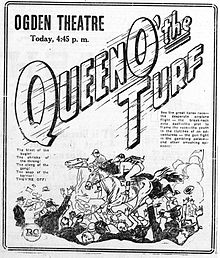Silks and Saddles (1921 film)
| Silks and Saddles | |
|---|---|
 Newspaper advertisement for the American release. | |
| Directed by | John K. Wells |
| Written by | John K. Wells |
| Based on | story by John Cosgrove |
| Produced by | John K. Wells |
| Starring | Brownie Vernon Robert MacKinnon |
| Cinematography | Alfred William Burne |
| Edited by | Robert Bates John K. Wells |
Production company | Commonwealth Pictures |
| Distributed by | The Carroll Brothers |
Release date | 5 March 1921[1] |
Running time | 5,500 feet |
| Country | Australia |
| Language | Silent (English intertitles) |
| Budget | £5,600[2] |
| Box office | £50,000[2] |
Silks and Saddles is a 1921 Australian silent film set in the world of horse racing that was directed by John K. Wells.
The film is also known as Queen o' Turf or Queen of the Turf in the United States.
Plot summary[edit]
On the stud farm of Kangarooie, squatter's daughter Bobbie wants her weak brother Richard to come home for her birthday, but she prefers the charms of the city, in particular the high society adventuress, Mrs Fane. Tubby Dennis O'Hara, who is in love with Bobbie, persuades Richard to come home and he brings Mrs Fane with him. O'Hara gives Bobbie his horse, Alert, as a present. Bobbie enters it in a race and Mrs Fane tries to stop her from winning. Bobbie falls in love with a handsome man and rides Alert to victory.[3]
Cast[edit]
- Brownie Vernon as Bobbie Morton
- Robert MacKinnon as Richard Morton Jr
- John Cosgrove as Dennis O'Hara
- John Faulkner as Richard Morton Sr
- Tal Ordell as Phillip Droone
- Evelyn Johnson as Myra Fane
- Raymond Lawrence as Jeffrey Manners
- Gerald Harcourt as Toby Makin
- Tommy Denman as Dingo
- Kennaquhair (horse) as Alert
Production[edit]
The film is one of the rare Australian movies to survive today almost in its entirety. It was made by Commonwealth Pictures, a company formed in October 1920 with Eric Griffin as managing director at a value of £10,000.[4] They hired John K. Wells to direct; he was an American who moved to Australia with Wilfred Lucas to work as an assistant director.
The movie was shot in and around Sydney, including at Randwick racecourse and at Camden, with interiors at E. J. Carroll's studio at Palmerston in Waverly.[5] Footage was taken involving an aeroplane, one of the first Australian movies to do so.[6] The champion race horse Kennaquhair appears.
Reception[edit]
Le Maistre Walker, who helped set up Commonwealth Pictures, later claimed the film earned £17,000 in Australasia, of which only £3,900 was returned to the company. The UK rights were sold for £3,000 and the American rights for $16,000. Walker says that the US distributors made £30,000 out of the film. However, because of the associated costs, Commonwealth could only return 23/ of every £1 invested, and soon went out of business.[2]
The film was the victim of block booking in the US so was retitled and edited to make it seem as if it was set in Virginia.[7]
Wells appears to have never directed another feature film.[5]
References[edit]
- ^ "Advertising". The Sydney Morning Herald. National Library of Australia. 5 March 1921. p. 2. Retrieved 26 July 2012.
- ^ a b c "PICTURE FILMS". The Sydney Morning Herald. National Library of Australia. 11 February 1925. p. 17. Retrieved 4 August 2012.
- ^ ""SILKS AND SADDLES."". The Register. Adelaide: National Library of Australia. 6 July 1921. p. 7. Retrieved 26 July 2012.
- ^ "COMPANY NEWS". The Sydney Morning Herald. National Library of Australia. 28 October 1920. p. 10. Retrieved 26 July 2012.
- ^ a b Andrew Pike and Ross Cooper, Australian Film 1900–1977: A Guide to Feature Film Production, Melbourne: Oxford University Press, 1998, 103.
- ^ ""SILKS AND SADDLES" AT WEST'S". The Register. Adelaide: National Library of Australia. 15 July 1921. p. 5. Retrieved 26 July 2012.
- ^ "A FINE AUSTRALIAN PICTURE". The Mercury. Hobart, Tas.: National Library of Australia. 28 November 1921. p. 4. Retrieved 26 July 2012.
External links[edit]
- Silks and Saddles at IMDb
- Silks and Saddles is available for free viewing and download at the Internet Archive
- Silks and Saddles at National Film and Sound Archive
